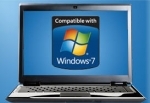
We’re coming into the home stretch for the release of Windows 7. Tuesday, May 5th 2009, Microsoft made Windows 7 RC 1 available for everyone. In an attempt to avoid a server-jamming rush, there are no time limits on downloading or the number of keys available. The servers are giving good to great download speeds.
So what do you need to get started with this new operating system? Traditionally, Microsoft has understated the minimum hardware requirements for new releases. This practice seems to have peaked with Vista, as those misrepresentations landed MS in court.
WINDOWS 7 UPGRADE ADVISOR Test your system now for hardware and software compatibility.
Today’s requirements for Windows 7 have remained flat, no increases from what was required for Vista. In fact the Operating system works so much better than Vista, using the same hardware, that it’s hard not to call this a reduction in hardware requirements.
SYSTEM SPECS
1. Processor = 1 GHz
2. RAM = 1 GB 32 bit/2GB 64 bit
3. Disc Space = 16 GB 32 bit/20 GB 64 bit
4. Video = DirectX 9 capable device with WDDM 1.0 or higher
5. Clean installation suggested.
That’s it, what’s not to like? Keep in mind, these are minimum requirements. Minimum requirements don’t equate to maximum pleasure. Heck, compared to what’s available and becoming the norm, I can’t imagine a wonderful experience with these specs regardless of the OS being used. Of course, I’m a hardware freak and find using even 2 year old hardware puts me in a sad mood.
I tried to find some old hardware to give it a whirl, but the garage larder held nothing like this. The other good news is that those who have tried using close to the minimum specs are giving good reports. Some have even given it a spin on their Netbooks using the Atom processors and report limited success. The “limited” part refers more to the lack of Intel Virtualization Technology on Atom Processors.
If there is a negative to the requirements, it seems to be the increased specifications for running in XP mode. Designed mostly as an enticement to businesses, running in XP Mode requires that your computer support Intel Virtualization Technology. Many current laptops don’t have Intel VT. The affected units will include those with Intel Celeron, Pentium Dual-Core, Pentium M, and Atom Processors. Don’t confuse Pentium Dual-Core with Intel Core2. The situation is better for AMD users. The majority of the AMD processors will support XP mode with Sempron being the exception.
This doesn’t mean you won’t be able to run Windows 7 with this hardware, it means you won’t be able to run Windows 7 in XP mode. XP Mode is important for a limited number of applications and will not be a big deal for most home users. I am not running anything close to the minimum specs, so those few times that programs like WordPress need the help of XP Mode, it’s kicked in with no problems or prompts. I do see this as a stumbling block for many business laptop users. I’m thinking I know a few with this problem.
A quick note to gamers, Windows 7 XP mode is not designed to help with Video Games.
The real news here is that Microsoft seems to be getting a lot of things right with this release. Is it possible they are actually starting to listen and consider the users? Competition and shrinking charts can be a wonderful thing.
_______________________________________________________________________________
Toms Hardware,/P>




